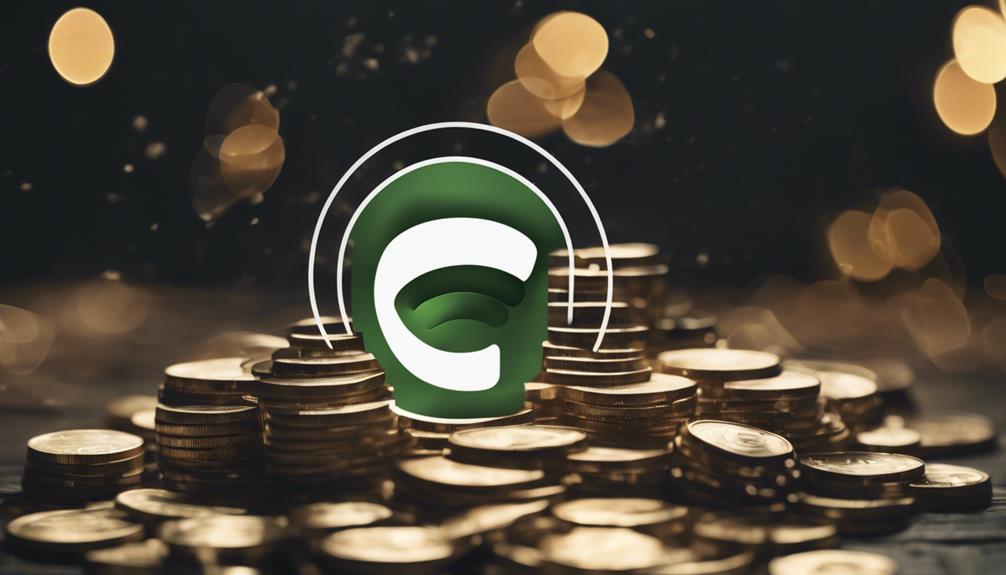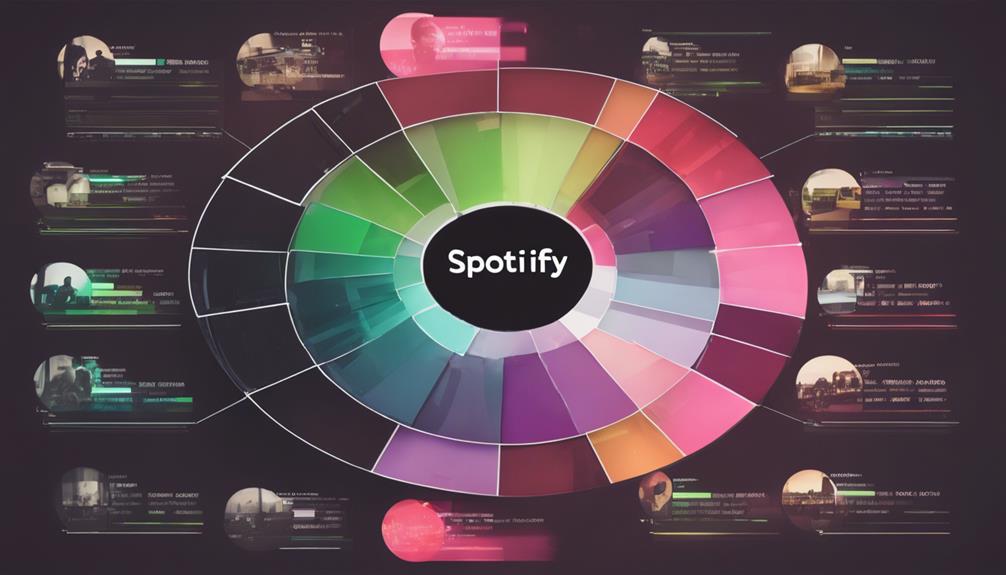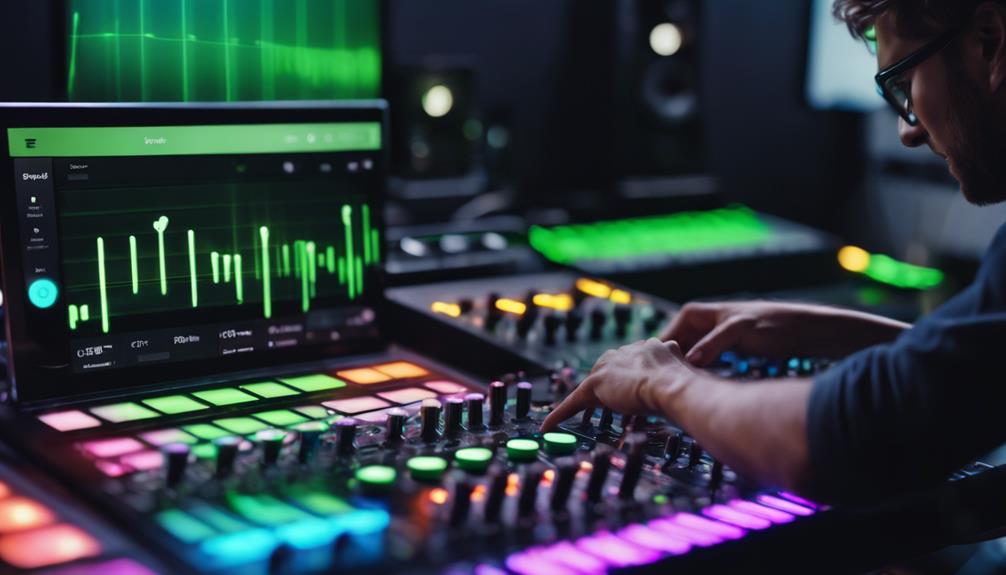
How much is 300k streams on Spotify?
You’re interested in the earning potential of Spotify streams. For Spotify, the average payout per stream generally falls between $0.003 and $0.005. With these rates, if your music garners 300K streams, you’d typically earn between $900 and $1500. This figure can be influenced by varying factors such as listener location and their account type. Make no mistake though, it isn’t a straightforward size equals payout scenario. Spotify’s internal systems, artist prominence, and active user dynamics affect how it dishes out royalty payments. Uncovering the specifics of this dynamic equation offers more insights into the streaming revenue maze.
Key Takeaways
- Spotify’s average payout per stream ranges from $0.003 to $0.005.
- The total revenue for an artist with 300K streams on Spotify is estimated to be around $1,200, assuming a payout rate of $0.004 per stream.
- The payout depends on the artist’s total share of streams, not on individual streams.
- The user’s subscription type, either Free or Premium, affects the stream value and hence the artist’s earnings.
- The location of the listener also influences the value of a stream on Spotify.
Understanding Spotify’s Business Model

Peeling back the layers of Spotify’s business model, you’ll find a complex ecosystem that thrives on a balance of ad-supported free access and premium subscriptions. This dual-revenue model isn’t unique to Spotify, but they’ve managed to optimize it in a way that keeps them ahead of Spotify’s competitors, like Apple Music and Tidal.
With 155 million premium subscribers and 345 million active users, Spotify’s business model seems to be working, but it’s not without its challenges. The company is continuously seeking innovative ways of revenue generation. One such example is podcast monetization.
In 2020, Spotify invested heavily in podcasts, acquiring podcast networks and launching its own ad platform. This move wasn’t just about content diversification, but about tapping into a rapidly growing market. Podcasts offer higher advertising revenue opportunities than music due to the ability to target ads based on listeners’ interests.
This opens up new possibilities for Spotify’s business model and presents an interesting case study in balancing user experience with profitability.
Deciphering Spotify’s Streaming Rates
You’ve come to grips with Spotify’s business model; now let’s clarify their streaming rates.
To fully appreciate your earnings from 300K streams, you’ll need an understanding of Spotify’s payment structure, the formula for calculating streaming earnings, and the various factors that impact payouts.
It’s more than just hits and skips; it’s a complex, multifaceted system that can greatly influence an artist’s revenue.
Understanding Spotify’s Payment Structure
To fully grasp how Spotify’s payment structure works, it’s imperative to delve into the intricacies of their streaming rates. This blend of payment disparities and royalty complexities creates a multi-faceted system that isn’t straightforward to comprehend.
Spotify calculates royalties based on a pro-rata model. This means that the total amount of revenue generated is divided among all artists based on their percentage of total streams. This system often benefits popular artists, leaving emerging ones with a smaller piece of the pie.
Here are some key points to keep in mind about Spotify’s payment structure:
- The payment you receive isn’t per stream, but based on your share of total streams.
- Rates can fluctuate, influenced by factors such as where the listeners are located or whether they’re using a free or premium account.
- A significant portion of Spotify’s revenue goes to rights holders, who then distribute it to artists based on their contracts.
- The royalty rate is generally low, making high streaming numbers crucial for significant earnings.
Understanding Spotify’s payment structure can be challenging. But with a keen eye for detail and an open mind, you can decipher the complexities and navigate this innovative streaming platform effectively.
Calculating Spotify Streaming Earnings
Let’s explore how you can calculate your potential earnings from Spotify streams, understanding the nuances of Spotify’s streaming rates. Spotify’s pay per stream isn’t a fixed rate, and it’s calculated based on multiple factors, including market share, total number of streams, and royalty rates.
To calculate your earnings, you’d first need to know the total number of streams your track has received. Multiply this by Spotify’s average payout per stream, which is reportedly between $0.003 and $0.005. This calculation will give you a rough estimate.
However, this process isn’t as straightforward as it seems. Your artist representation plays a significant role in negotiating the royalty rates. You, as an artist, mightn’t receive the entire payout due to deductions made by record labels, distributors, or management.
Moreover, Spotify has stringent measures to detect stream fraudulence. Artificially inflated streams won’t count towards your earnings. They’re identified and removed from the calculation. So, genuine engagement is important for earning from your streams.
Factors Affecting Spotify Payouts
Understanding the payout per stream on Spotify is a complex process, influenced by numerous factors that we’re about to explore in depth. Here’s where the Spotify algorithm and curated playlists come into play, among other factors.
- The Spotify algorithm: This high-tech tool has a direct impact on your payout. It’s designed to promote tracks based on listener behavior, which can boost your streams and, subsequently, your earnings.
- Curated playlists: Being featured on a popular playlist can greatly increase your visibility and streams. However, it’s the playlist curator who decides which songs make the cut.
- Market location: Streams from different regions have different values, with developed markets typically paying more per stream.
- Listener’s subscription type: Free users generate less revenue than premium subscribers. The more premium listeners you have, the higher your payout.
These factors are intricate and can change dynamically. It’s a game of strategizing, understanding your audience and maneuvering through the complexities of the Spotify landscape.
The Role of Spotify’s Royalty Distribution

While you might be thrilled about hitting 300K streams on Spotify, it’s important to understand how the platform’s royalty distribution plays a significant role in your earnings.
Spotify’s royalty system isn’t as simple as you may think. It’s a complex web of royalty transparency, copyright issues, and various agreements between Spotify, record labels, and rights holders.
Royalty transparency is a key factor in Spotify’s royalty distribution. The platform uses a pro-rata model to calculate royalties, dividing the total revenue among all rights holders, based on the number of streams. However, this process lacks transparency as the exact formula isn’t disclosed, causing some artists to feel underpaid.
Furthermore, Spotify’s royalty distribution is mired in copyright issues. The platform has been embroiled in legal battles due to lack of necessary licenses for some songs. When copyright issues arise, royalties may be withheld, affecting your potential earnings.
In essence, the role of Spotify’s royalty distribution is tantamount to the financial success of your music on the platform. Understanding its intricacies can empower you to navigate this digital music landscape more effectively, and potentially earn more from your streams.
The Influence of Geographical Location
Exploring the domain of geographical influence, it’s fascinating to note how your location can greatly impact the number of streams and subsequent earnings on Spotify. Regional royalties differ based on the listener’s location, meaning the same song played in different parts of the world will generate different amounts of revenue.
Streaming demographics also play a significant role. Your profitability hinges on who’s listening and where they are. The more your music is streamed in high royalty regions, the more you stand to earn. But it’s not just about the numbers.
Consider the following:
- With a global audience, your music has the power to cross borders and resonate with people from diverse backgrounds.
- Targeting specific geographical locations can help you maximize your earnings.
- Understanding regional musical preferences can inform your creative process.
- Embracing the global nature of streaming platforms can help you reach untapped markets.
In essence, the geographical location of your audience can be a game-changer for your streaming revenue. It’s less about the volume and more about geographical impact. Play smart with your music and let the world dance to your beat.
Impact of User Subscription Plans

Often overlooked, the type of user subscription plans on Spotify greatly influences your streaming revenue. The platform offers two main types of subscriptions: Free and Premium. The revenue generated from Premium listeners is notably higher than that from Free listeners. This difference stems from the premium benefits, such as ad-free listening and higher audio quality, which command a monthly fee, a portion of which is allocated to artists based on their share of total streams.
However, the volatility of subscription plans presents a challenge. Subscription cancellation, for instance, can dramatically impact your earnings. If a large number of your Premium listeners decide to cancel their subscriptions, your revenue could take a hit. Hence, it’s important to understand your audience’s subscription habits, as well as the ways you can encourage them to upgrade from Free to Premium.
Innovation is key in this ever-evolving landscape. You must continuously reinvent your music and engagement strategies to keep your listeners captivated and reduce the risk of subscription cancellation. Remember, the more Premium listeners you have, the higher your potential earnings from streaming.
Case Study: Earnings From 300K Streams
To illustrate the potential earnings from streaming, let’s examine a hypothetical scenario where an artist garners 300K streams on Spotify. Assume a payout rate of $0.004 per stream, a standard in the industry. This would yield a total revenue of $1,200 for the artist.
However, it isn’t as straightforward as it seems due to factors like stream demographics and revenue diversification.
Consider these factors:
- User subscription plans: Premium listeners contribute more to your earnings than free tier listeners.
- Stream demographics: Streams from countries with higher Spotify subscription costs have a higher payout.
- Artist’s deal with their record label: The proportion of revenue you receive depends on your agreement.
- Revenue diversification: Relying solely on streaming revenue mightn’t be sustainable. Merchandise sales, concerts, or sponsorships can supplement your income.
These complexities emphasize the need for an innovative approach in the music industry. It’s not just about racking up the streams, but understanding how they translate into earnings and finding ways to maximize them. Be mindful of these nuances and plan accordingly.
This will ensure that you’re not just making music, but also making a living out of your passion.
Tips for Increasing Spotify Streams

You’ve seen the potential earnings from 300K streams, now let’s explore how you can boost your own numbers.
Consider strategic placements on Spotify playlists, collaborations to boost streams, and effective social media promotion.
These tips aren’t only practical but also tested strategies to help increase your Spotify streams.
Spotify Playlist Placement Strategy
While securing a spot on a popular Spotify playlist might seem intimidating, it’s an effective strategy that can greatly boost your stream count, provided you approach it with a well-thought-out plan and a clear understanding of the platform’s algorithm. Key to this strategy is the art of playlist curation and audience targeting.
You need to guarantee your music matches the theme or vibe of the playlist you’re targeting, and that the playlist caters to your genre’s audience.
Consider these innovative strategies to increase your chances of playlist placement:
- Engage with Spotify’s algorithm: Regularly update your playlists and encourage fans to follow and share them. This active engagement can enhance your visibility to Spotify’s algorithm.
- Tailor your music to playlist themes: Craft your music to suit the mood, theme, or genre of the playlists you aim to be featured on.
- Promote your music on social media: Leverage the power of social networks to reach a wider audience, increasing the chances of your music being added to user-curated playlists.
- Understand your audience: Analyze your listeners’ behavior and preferences to tailor your music, making it more appealing for playlist curators.
Collaborations for Stream Boost
Beyond securing playlist placements, another proven method to bolster your Spotify streams is by initiating strategic collaborations with other artists. Artist Partnerships not only expand your reach but also diversify your sound, attracting new audiences and greatly boosting your streaming numbers.
To optimize these collaborations, it’s imperative to partner with artists who complement your style, yet provide a unique element to your music. This synergy can create a compelling musical experience that sparks listener interest and encourages repeat streams. It’s not just about the number of collaborations, but the quality and strategic fit of the partnered artists.
Moreover, consider collaborating with artists who’ve a strong digital presence. Their online influence can help promote your joint venture, subsequently driving more streams. Remember, every stream counts. An influential collaborator can increase your exposure and bring you closer to your 300K stream goal.
Streaming Optimization goes beyond your solo efforts. It’s about leveraging collective strength and tapping into new fan bases through strategic collaborations.
Effective Social Media Promotion
Utilizing the power of social media can greatly boost your Spotify streams, making it an essential tool in your music promotion arsenal. The strategy begins with content optimization. You must create your posts with precision, making sure they’re appealing and engaging. Tailor your content to suit the platform’s demographics and trends, incorporating keywords relevant to your music genre.
Influencer engagement is another powerful tactic. Collaborating with influencers can amplify your reach and credibility. Make sure you partner with influencers who resonate with your style and audience.
Here are some innovative ways to effectively engage your audience:
- Run contests or giveaways that encourage your audience to stream and share your music.
- Share snippets of your songs or behind-the-scenes footage to pique interest.
- Collaborate with other artists on social media live sessions.
- Use interactive features like polls, Q&As, and challenges to foster engagement.
The Future of Streaming Revenue
As you dive deeper into the world of streaming, it’s evident that the future of streaming revenue holds immense potential for artists, with more opportunities for monetization than ever before. Streaming sustainability and revenue diversification are the new catchphrases in this evolving digital landscape.
Streaming sustainability isn’t just about the number of streams. It’s about building a stable, long-term income source through various channels. This includes live stream performances, fan subscriptions, direct-to-fan sales, and more.
In the same vein, revenue diversification is becoming increasingly critical. Artists who diversify their income streams are less dependent on a single platform’s revenue model and are more resilient against industry fluctuations.
Innovation is key in this future outlook. The rise of technologies like blockchain could redefine streaming economics, allowing artists to earn more through direct, peer-to-peer transactions. Virtual reality concerts offer new avenues for fan engagement and revenue generation.
And as AI becomes more integrated into music production, it could open up new possibilities for rights management and royalty distribution.
In short, the future of streaming revenue is bright, but it demands a proactive, innovative approach from artists. Understanding and leveraging these trends can have a substantial impact on your earnings from those 300K Spotify streams.

